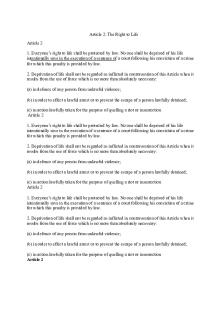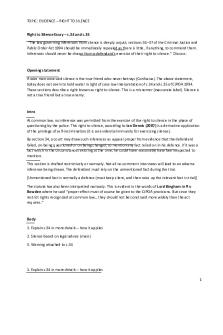Right to an Occupation Fee PDF

| Title | Right to an Occupation Fee |
|---|---|
| Course | Property Law |
| Institution | University of Queensland |
| Pages | 1 |
| File Size | 43.8 KB |
| File Type | |
| Total Downloads | 60 |
| Total Views | 157 |
Summary
Rights and obligations of the co-owners inter se that arise from the facts...
Description
Right to an Occupation Fee Where a joint tenant leaves the property and is no longer an occupying co-owner, the law will treat her as choosing to leave and not exercising their legal right to occupy the land (unity of possession). Yet, evidence of an ouster or exclusion of JT from the land may arrive to another conclusion. An ouster occurs where the co-owner is excluded or dispossessed from the property (Re Thurgood; Biviano v Natoli; Callow v Rupchev). There must be a demonstration by a JT of having excluded the non-occupying co-owner – in other words their actions must be inconsistent with the non-occupying co-owner’s enjoyment with the land. E.g. changing the locks and keys On the other hand, if the principle from Callow v Rupchev can be enlivened to show that there has been a breakdown of a ‘domestic’/’matrimonial’ relationship then this would amount to exclusion. The remedy for an ouster situation would be an occupation fee payable by the excluding JT to the non-occupying co-owner that as excluded (Re Thurgood; Biviano v Natoli). Combined with the factors above, without an agreement between the parties indicating otherwise, the non-occupying co-owner will not have a right to a fee. On the facts, JT left because they were “sick and tired of living there”. this is insufficient to entail exclusion by JT of them....
Similar Free PDFs

Right to an Occupation Fee
- 1 Pages

Right to infomration notes
- 77 Pages

Right TO Information
- 4 Pages

Right to Support
- 5 Pages

Right to information
- 5 Pages

Occupation order
- 8 Pages

Problem Question Right to Cancel
- 11 Pages

Article 2 Right to Life
- 8 Pages

Vetassess general occupation list
- 33 Pages

British Occupation OF Assam
- 7 Pages

Conditional fee agreements guide
- 7 Pages
Popular Institutions
- Tinajero National High School - Annex
- Politeknik Caltex Riau
- Yokohama City University
- SGT University
- University of Al-Qadisiyah
- Divine Word College of Vigan
- Techniek College Rotterdam
- Universidade de Santiago
- Universiti Teknologi MARA Cawangan Johor Kampus Pasir Gudang
- Poltekkes Kemenkes Yogyakarta
- Baguio City National High School
- Colegio san marcos
- preparatoria uno
- Centro de Bachillerato Tecnológico Industrial y de Servicios No. 107
- Dalian Maritime University
- Quang Trung Secondary School
- Colegio Tecnológico en Informática
- Corporación Regional de Educación Superior
- Grupo CEDVA
- Dar Al Uloom University
- Centro de Estudios Preuniversitarios de la Universidad Nacional de Ingeniería
- 上智大学
- Aakash International School, Nuna Majara
- San Felipe Neri Catholic School
- Kang Chiao International School - New Taipei City
- Misamis Occidental National High School
- Institución Educativa Escuela Normal Juan Ladrilleros
- Kolehiyo ng Pantukan
- Batanes State College
- Instituto Continental
- Sekolah Menengah Kejuruan Kesehatan Kaltara (Tarakan)
- Colegio de La Inmaculada Concepcion - Cebu




